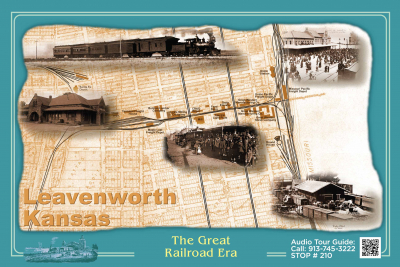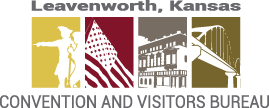Wayside Tour #10: The Great Railroad Era
Wayside Tour #10: The Great Railroad Era
The railroad era began in the eastern part of the United States in the 1830’s when the Baltimore and Ohio Railroad opened with thirteen miles of track. Most of the lines were built in the Northeast and Old Northwest. The first Kansas Territorial Legislature chartered five railroad companies in 1855. Two were the Leavenworth and Lecompton, and the Leavenworth, Pawnee and Western. Two years later, the legislature approved supplementing the original charter of the Leavenworth, Pawnee and Western line by authorizing the building of branch lines and ferries.
Several roads were built in the 1860’s and 1870’s. The Missouri River Railroad was built from Wyandotte north through Leavenworth to join the Missouri Pacific at the Nebraska border. The line later became part of the Missouri Pacific system. The Leavenworth City Railroad Company was chartered by the Territorial Legislature in 1860 to provide transportation between the city and Fort Leavenworth. The interurban was later expanded to provide service in Kansas City, Kansas.
Green’s Leavenworth Directory of 1880 lists eight railroads as serving Leavenworth at that time. They were the Chicago, Rock Island, Hannibal and St. Joseph Railroad, Kansas Central Railroad, Kansas City, St. Joseph and Council Bluffs Railroad, Kansas Pacific Railroad, Leavenworth, Lawrence and Galveston Railroad, and the St. Louis, Kansas City and Northern Railroad. The location of their Ticket Office, Passenger Depots and Freight Depots are identified on the legend on the artwork before you.
James A. McGonigle, a distinguished local architect and builder, was awarded the contract to build Union Depot in Leavenworth which was completed in 1888. The McGonigle firm also built facilities for the Santa Fe Railroad. That railroad maintained a separate depot, with ticket and freight offices at Seventh and Shawnee Streets.
It was an early hope that Leavenworth would serve as a center for collection and distribution of goods, and that the major lines would make Leavenworth a transportation hub for the nation. Those hopes were not realized. Probably the most important reason that Leavenworth did not become a major rail hub was the lack of a bridge across the Missouri River. Kansas City won the race by completing the Hannibal and St. Joseph Bridge connecting Missouri and Kansas near the confluence of the Missouri and Kaw Rivers. Kansas City, thus became the terminus of major railroads, and branch lines served Leavenworth.
A final attempt by Leavenworth investors to make the city a rail center led to the awarding of a charter in 1871 to construct the Kansas Central Railroad. The road was to be a narrow gauge line from Leavenworth to the western border of Kansas by the most direct route possible and using local feeder lines as connecting points. However, the project failed. The adoption of standard railroad gauges made the narrow gauge roads obsolete. Better-equipped lines served Kansas and that competition proved fatal to the plans for the Kansas Central Railroad Company.
When the major railroad lines were completed and the small feeder lines absorbed, Leavenworth was served by the Missouri Pacific and Union Pacific, and by the Atchison, Topeka and Santa Fe lines. Over time the railroads had replaced the steamboats, and in the 1920’s a new transportation revolution, the automobile, began to replace the railroads, at least as provider of passenger service. The invention of the automobile brought new lifestyles to Americans. The railroads continued to operate passenger service but there was a marked decrease in ridership. Passenger service to Leavenworth ended in 1965. Today the railroads are major carriers of freight and farm products. A few passenger trains survive, but the heyday of the railroad has passed.
With the ending of passenger service to Leavenworth, the Union Depot lost its prominence as a center of traffic. The city now utilizes the Union Depot as the Leavenworth Community Center.



